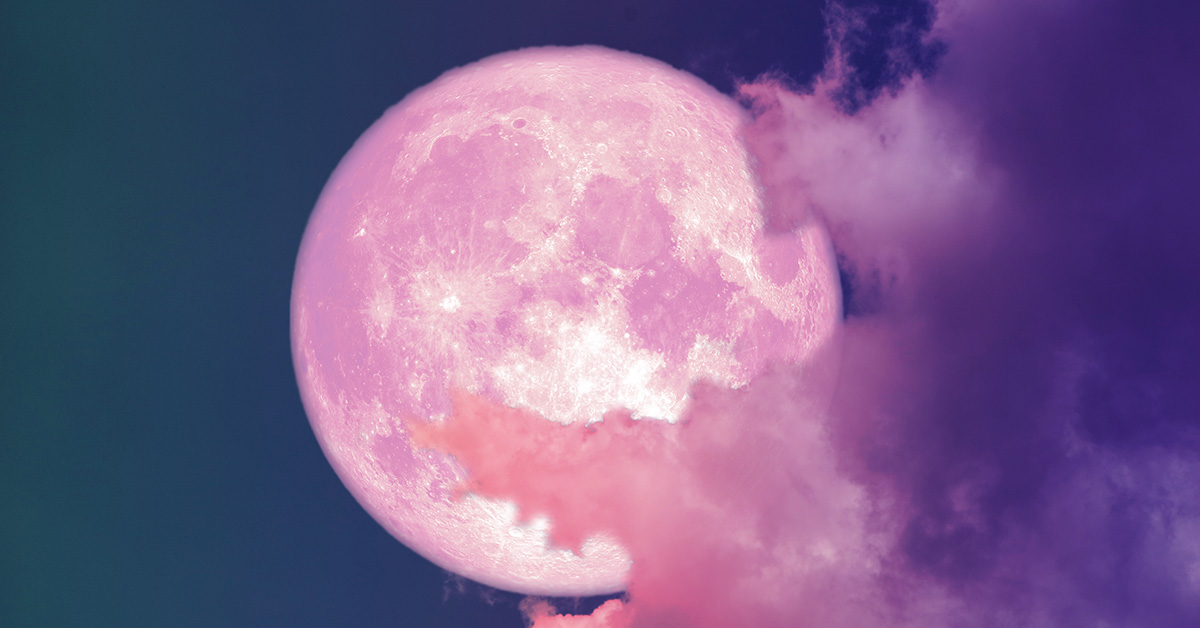As spring finally arrives, keep an eye on the sky as you unpack your barbeque and lawn chairs. On April 26, 2021, look out for the super pink moon. This phenomenon occurs when the moon comes closest to Earth. This shorter distance makes the full moon look especially large and bright.
Unfortunately, it doesn’t actually turn pink, although this misnomer is honestly disappointing. Actually, the super pink moon name comes from a North American wildflower called “moss pink” that usually blooms in April at the same time as this bright moon.
The super pink moon will be visible from April 26 to April 27. The exact moment of perigee (when the moon will be closest to Earth) will occur at 11:31 p.m. EDT. If you can’t stay up that late, keep an eye on the horizon, which is where the moon will appear the biggest. [1] This is actually the first of the two pink moons of this year. The second will occur on May 26.
A Moon With Many Names
To be more precise, super moons are about 7% bigger and about 15% brighter than an average full moon. However, unless you could have both moons in the sky at once, the difference isn’t very noticeable.
Although April’s full moon got the name “pink moon” after the moss pink, it has many other names. Some reference the coming season of spring, like Algonquin’s Breaking Ice Moon, Dakota’s Moon When the Streams Are Again Navigable — which particularly references the newborn mobility after a long winter. Other names refer to the coming plant growth, like Tlingit’s Budding Moon of Plants and Shrub,s and Oglala’s Moon of the Red Grass Appearing.
Spring also means the return of different animals, which inspired Moon When the Ducks Come Back from Lakota tribes, Moon When the Geese Lay Eggs from Dakota, and Frog Moon from Cree. Similarly, Sucker Moon from the Anishinaabe people pays tribute to the harvest for suckerfish as they return to the rivers to spawn. [2]
On the flipside — literally, in New Zealand — the Māori people see the April moon as the arrival of autumn. Therefore, they call this moon “Paenga-whāwhā,” which refers to the season when “all straw is now stacked at the borders of the plantations.”
However, these natural events are not the only ones marked by the super pink moon. Easter as well as the Jewish Passover and the Hindu holiday called Hanuman Jayanti usually fall around this time of year. [3]
The Science Behind the Super Pink Moon
Every month, the full moon appears when the moon is on the opposite side of Earth from the sun. When the moon falls under the shadow of our planet, a solar eclipse appears. However, this April moon will avoid this occurrence since the moon’s orbit is several degrees off.
According to Jesse Emspak from Space.com, “Through binoculars or a small telescope, the full moon appears so bright it can be hard to see details because there are no shadows to give any contrast. From a lunar observer’s perspective, the sun would be directly overhead — it would be noontime. Moon filters are available that can make some features stand out, but waiting a few days after the full moon or observing a few days before, shadows bring out more detail.” [4]
More Celestial Events in 2021
As the pandemic continues, some places are still in lockdown while others aren’t anymore. So depending on where you live, your sky-watch parties could either be solo or with company. For the best view, visit state or federal parks that are away from city lights. Even turning off the lights on your porch could help improve your home-viewing experience.
April 21 to 22: Lyrids Meteor Shower
In the Northern Hemisphere, a meteor shower will rain this April, with the peak seeing times around pre-dawn if you’re willing to stay up late or wake up early.
May 26: Total Lunar Eclipse
The shadow of the Earth will fall over the moon in a stunning total lunar eclipse. Most people in the United States will witness a partial eclipse in the early morning of May 26, around 4:44 a.m. The moon will appear bright orange.
June 10: Annular Solar Eclipse
Canada, Greenland, and Russia will be privy to a beautiful annular solar eclipse later this year. In this case, the sun’s “ring of fire” will encircle the shadowed moon.
Warning: Do not look directly at eclipses since they are dangerous for the naked eye. Purchase solar filters or specialized glasses, and even with these, avoid looking directly at the sky as they could still cause retinal damage. [5]
Fortunately, you could enjoy the super pink moon without protection when it arrives next month.
Keep Reading: Amethyst Meaning, Properties, Uses, And Powers
Sources
- “Don’t Miss the Super Pink Moon Coming in April 2021.” Mental Floss. Michele Debczak.March 19, 2021
- “Full Moon for April 2021.” The Old Farmer’s Almanac. Catherine Boeckmann. March 11, 2021
- “Pink Moon: Why the moon won’t actually be pink in April.” BBC. April 8, 2020
- “April Full Moon 2020: ‘Super Pink Moon,’ the biggest of the year, rises Tuesday.” Space. Jesse Emspak. April 6, 2020
- “TEN CELESTIAL EVENTS TO LOOK FORWARD TO IN 2021.” Smithsonian Mag. Nora McGreevy. January 7, 2021

